Individual Coursework: Analytical Thinking and Decision Making Report
VerifiedAdded on 2022/10/31
|13
|3510
|252
Report
AI Summary
This report analyzes the application of the Simple Multi-Attribute Rating Technique (SMART) for decision-making, focusing on a marketing problem faced by Primark. It begins by establishing the importance of decision-making and the application of decision analysis in the corporate world, highlighting tools like decision trees and Expected Value (EV). The report then identifies decision problems involving multiple objectives, specifically Primark's need to identify its target market. It outlines the SMART technique, detailing its phases from identifying the decision to performing sensitivity analysis. The report further discusses the strengths and limitations of the SMART analysis in this context, providing a comprehensive overview of the decision-making process and its application to a real-world business scenario. The report concludes by summarizing the key findings and the effectiveness of the SMART technique for solving the identified decision problem.
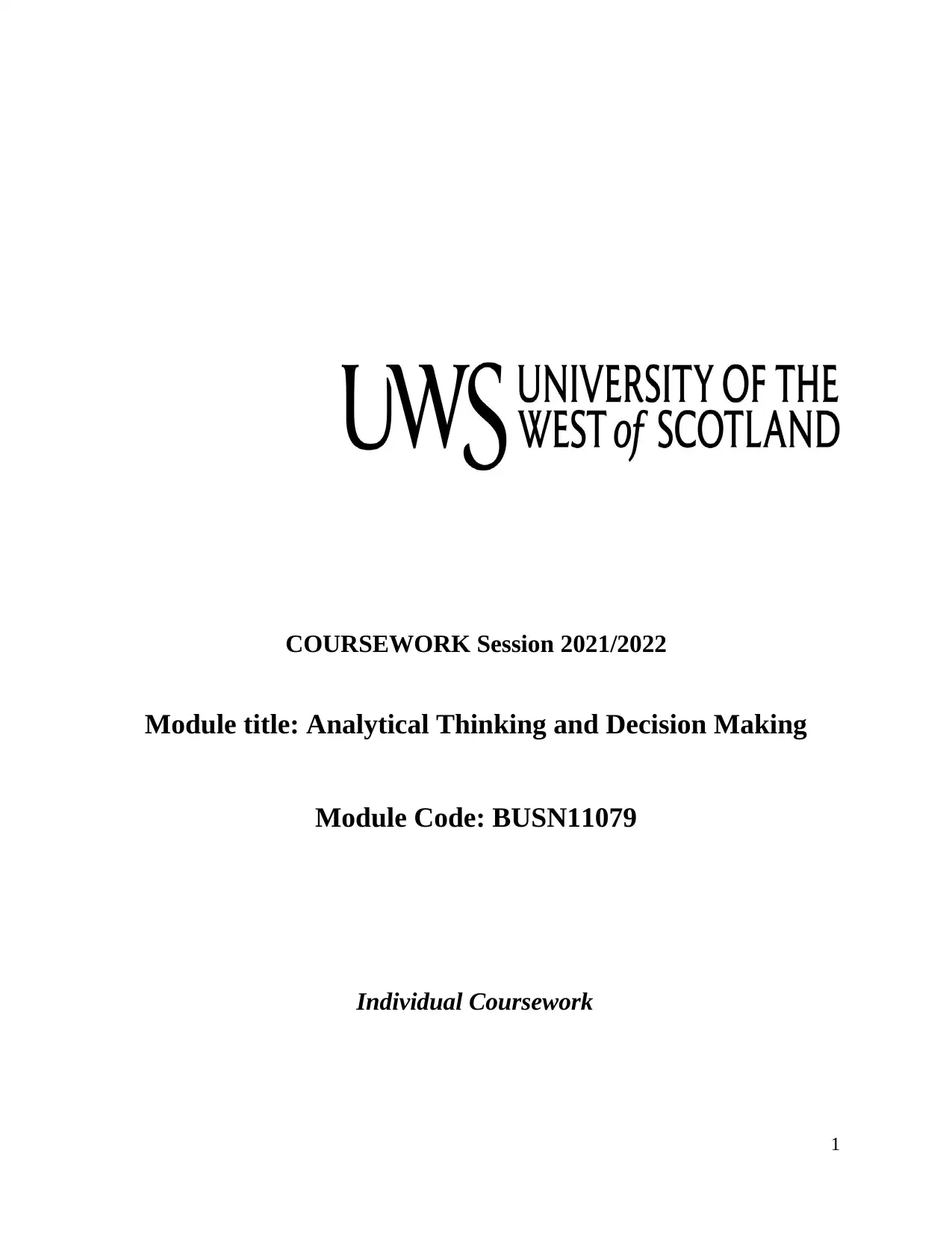
COURSEWORK Session 2021/2022
Module title: Analytical Thinking and Decision Making
Module Code: BUSN11079
Individual Coursework
1
Module title: Analytical Thinking and Decision Making
Module Code: BUSN11079
Individual Coursework
1
Paraphrase This Document
Need a fresh take? Get an instant paraphrase of this document with our AI Paraphraser
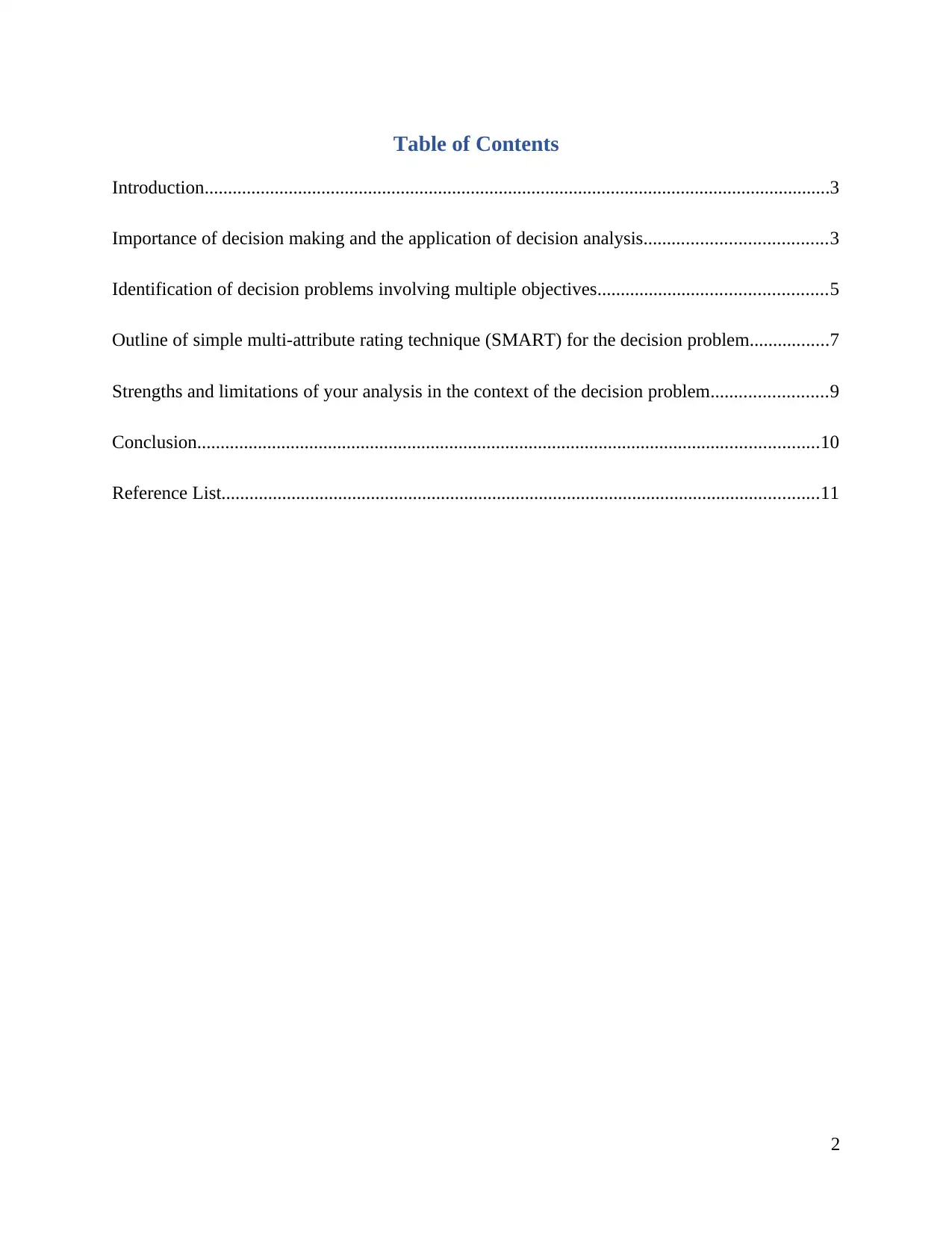
Table of Contents
Introduction......................................................................................................................................3
Importance of decision making and the application of decision analysis.......................................3
Identification of decision problems involving multiple objectives.................................................5
Outline of simple multi-attribute rating technique (SMART) for the decision problem.................7
Strengths and limitations of your analysis in the context of the decision problem.........................9
Conclusion.....................................................................................................................................10
Reference List................................................................................................................................11
2
Introduction......................................................................................................................................3
Importance of decision making and the application of decision analysis.......................................3
Identification of decision problems involving multiple objectives.................................................5
Outline of simple multi-attribute rating technique (SMART) for the decision problem.................7
Strengths and limitations of your analysis in the context of the decision problem.........................9
Conclusion.....................................................................................................................................10
Reference List................................................................................................................................11
2
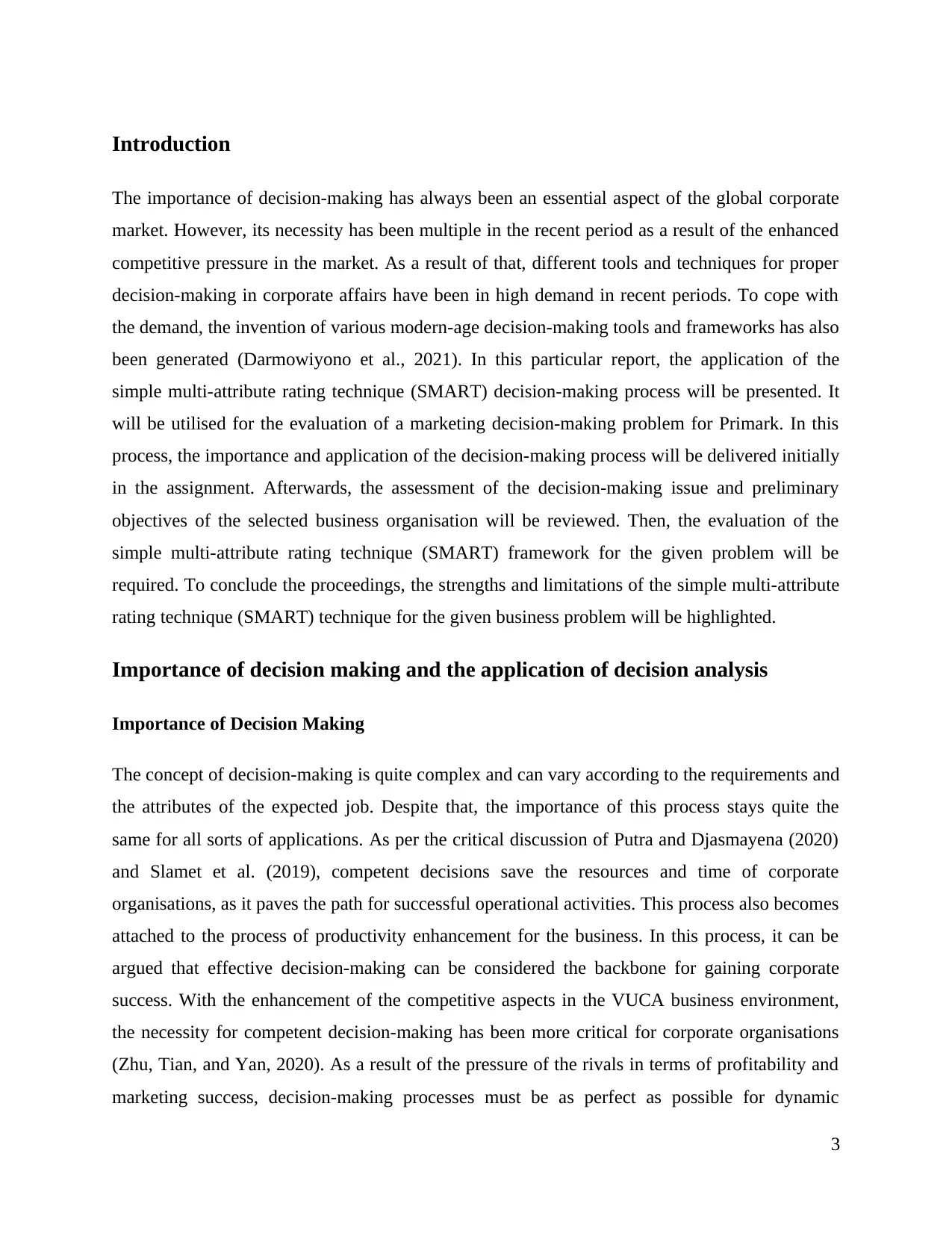
Introduction
The importance of decision-making has always been an essential aspect of the global corporate
market. However, its necessity has been multiple in the recent period as a result of the enhanced
competitive pressure in the market. As a result of that, different tools and techniques for proper
decision-making in corporate affairs have been in high demand in recent periods. To cope with
the demand, the invention of various modern-age decision-making tools and frameworks has also
been generated (Darmowiyono et al., 2021). In this particular report, the application of the
simple multi-attribute rating technique (SMART) decision-making process will be presented. It
will be utilised for the evaluation of a marketing decision-making problem for Primark. In this
process, the importance and application of the decision-making process will be delivered initially
in the assignment. Afterwards, the assessment of the decision-making issue and preliminary
objectives of the selected business organisation will be reviewed. Then, the evaluation of the
simple multi-attribute rating technique (SMART) framework for the given problem will be
required. To conclude the proceedings, the strengths and limitations of the simple multi-attribute
rating technique (SMART) technique for the given business problem will be highlighted.
Importance of decision making and the application of decision analysis
Importance of Decision Making
The concept of decision-making is quite complex and can vary according to the requirements and
the attributes of the expected job. Despite that, the importance of this process stays quite the
same for all sorts of applications. As per the critical discussion of Putra and Djasmayena (2020)
and Slamet et al. (2019), competent decisions save the resources and time of corporate
organisations, as it paves the path for successful operational activities. This process also becomes
attached to the process of productivity enhancement for the business. In this process, it can be
argued that effective decision-making can be considered the backbone for gaining corporate
success. With the enhancement of the competitive aspects in the VUCA business environment,
the necessity for competent decision-making has been more critical for corporate organisations
(Zhu, Tian, and Yan, 2020). As a result of the pressure of the rivals in terms of profitability and
marketing success, decision-making processes must be as perfect as possible for dynamic
3
The importance of decision-making has always been an essential aspect of the global corporate
market. However, its necessity has been multiple in the recent period as a result of the enhanced
competitive pressure in the market. As a result of that, different tools and techniques for proper
decision-making in corporate affairs have been in high demand in recent periods. To cope with
the demand, the invention of various modern-age decision-making tools and frameworks has also
been generated (Darmowiyono et al., 2021). In this particular report, the application of the
simple multi-attribute rating technique (SMART) decision-making process will be presented. It
will be utilised for the evaluation of a marketing decision-making problem for Primark. In this
process, the importance and application of the decision-making process will be delivered initially
in the assignment. Afterwards, the assessment of the decision-making issue and preliminary
objectives of the selected business organisation will be reviewed. Then, the evaluation of the
simple multi-attribute rating technique (SMART) framework for the given problem will be
required. To conclude the proceedings, the strengths and limitations of the simple multi-attribute
rating technique (SMART) technique for the given business problem will be highlighted.
Importance of decision making and the application of decision analysis
Importance of Decision Making
The concept of decision-making is quite complex and can vary according to the requirements and
the attributes of the expected job. Despite that, the importance of this process stays quite the
same for all sorts of applications. As per the critical discussion of Putra and Djasmayena (2020)
and Slamet et al. (2019), competent decisions save the resources and time of corporate
organisations, as it paves the path for successful operational activities. This process also becomes
attached to the process of productivity enhancement for the business. In this process, it can be
argued that effective decision-making can be considered the backbone for gaining corporate
success. With the enhancement of the competitive aspects in the VUCA business environment,
the necessity for competent decision-making has been more critical for corporate organisations
(Zhu, Tian, and Yan, 2020). As a result of the pressure of the rivals in terms of profitability and
marketing success, decision-making processes must be as perfect as possible for dynamic
3
⊘ This is a preview!⊘
Do you want full access?
Subscribe today to unlock all pages.

Trusted by 1+ million students worldwide
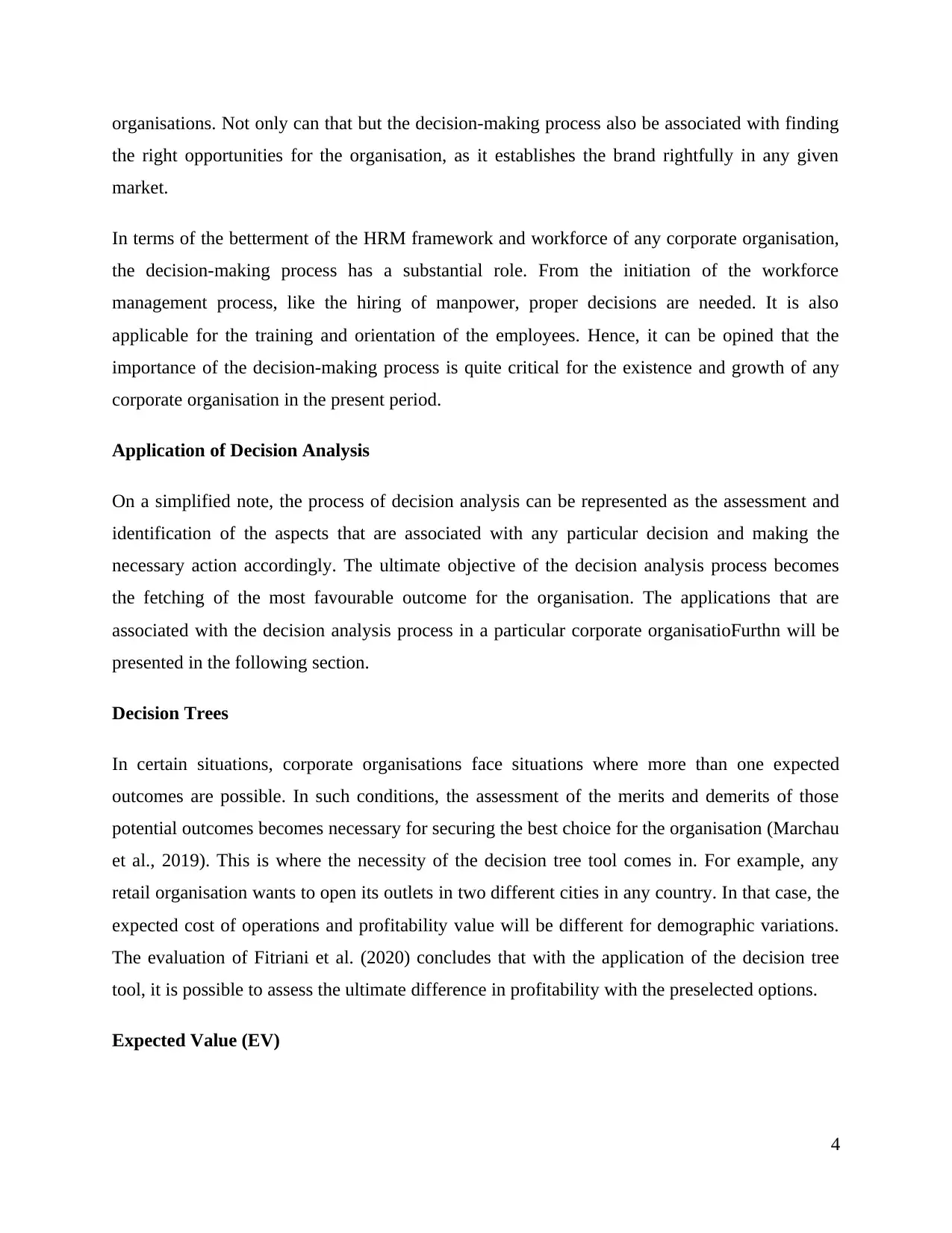
organisations. Not only can that but the decision-making process also be associated with finding
the right opportunities for the organisation, as it establishes the brand rightfully in any given
market.
In terms of the betterment of the HRM framework and workforce of any corporate organisation,
the decision-making process has a substantial role. From the initiation of the workforce
management process, like the hiring of manpower, proper decisions are needed. It is also
applicable for the training and orientation of the employees. Hence, it can be opined that the
importance of the decision-making process is quite critical for the existence and growth of any
corporate organisation in the present period.
Application of Decision Analysis
On a simplified note, the process of decision analysis can be represented as the assessment and
identification of the aspects that are associated with any particular decision and making the
necessary action accordingly. The ultimate objective of the decision analysis process becomes
the fetching of the most favourable outcome for the organisation. The applications that are
associated with the decision analysis process in a particular corporate organisatioFurthn will be
presented in the following section.
Decision Trees
In certain situations, corporate organisations face situations where more than one expected
outcomes are possible. In such conditions, the assessment of the merits and demerits of those
potential outcomes becomes necessary for securing the best choice for the organisation (Marchau
et al., 2019). This is where the necessity of the decision tree tool comes in. For example, any
retail organisation wants to open its outlets in two different cities in any country. In that case, the
expected cost of operations and profitability value will be different for demographic variations.
The evaluation of Fitriani et al. (2020) concludes that with the application of the decision tree
tool, it is possible to assess the ultimate difference in profitability with the preselected options.
Expected Value (EV)
4
the right opportunities for the organisation, as it establishes the brand rightfully in any given
market.
In terms of the betterment of the HRM framework and workforce of any corporate organisation,
the decision-making process has a substantial role. From the initiation of the workforce
management process, like the hiring of manpower, proper decisions are needed. It is also
applicable for the training and orientation of the employees. Hence, it can be opined that the
importance of the decision-making process is quite critical for the existence and growth of any
corporate organisation in the present period.
Application of Decision Analysis
On a simplified note, the process of decision analysis can be represented as the assessment and
identification of the aspects that are associated with any particular decision and making the
necessary action accordingly. The ultimate objective of the decision analysis process becomes
the fetching of the most favourable outcome for the organisation. The applications that are
associated with the decision analysis process in a particular corporate organisatioFurthn will be
presented in the following section.
Decision Trees
In certain situations, corporate organisations face situations where more than one expected
outcomes are possible. In such conditions, the assessment of the merits and demerits of those
potential outcomes becomes necessary for securing the best choice for the organisation (Marchau
et al., 2019). This is where the necessity of the decision tree tool comes in. For example, any
retail organisation wants to open its outlets in two different cities in any country. In that case, the
expected cost of operations and profitability value will be different for demographic variations.
The evaluation of Fitriani et al. (2020) concludes that with the application of the decision tree
tool, it is possible to assess the ultimate difference in profitability with the preselected options.
Expected Value (EV)
4
Paraphrase This Document
Need a fresh take? Get an instant paraphrase of this document with our AI Paraphraser
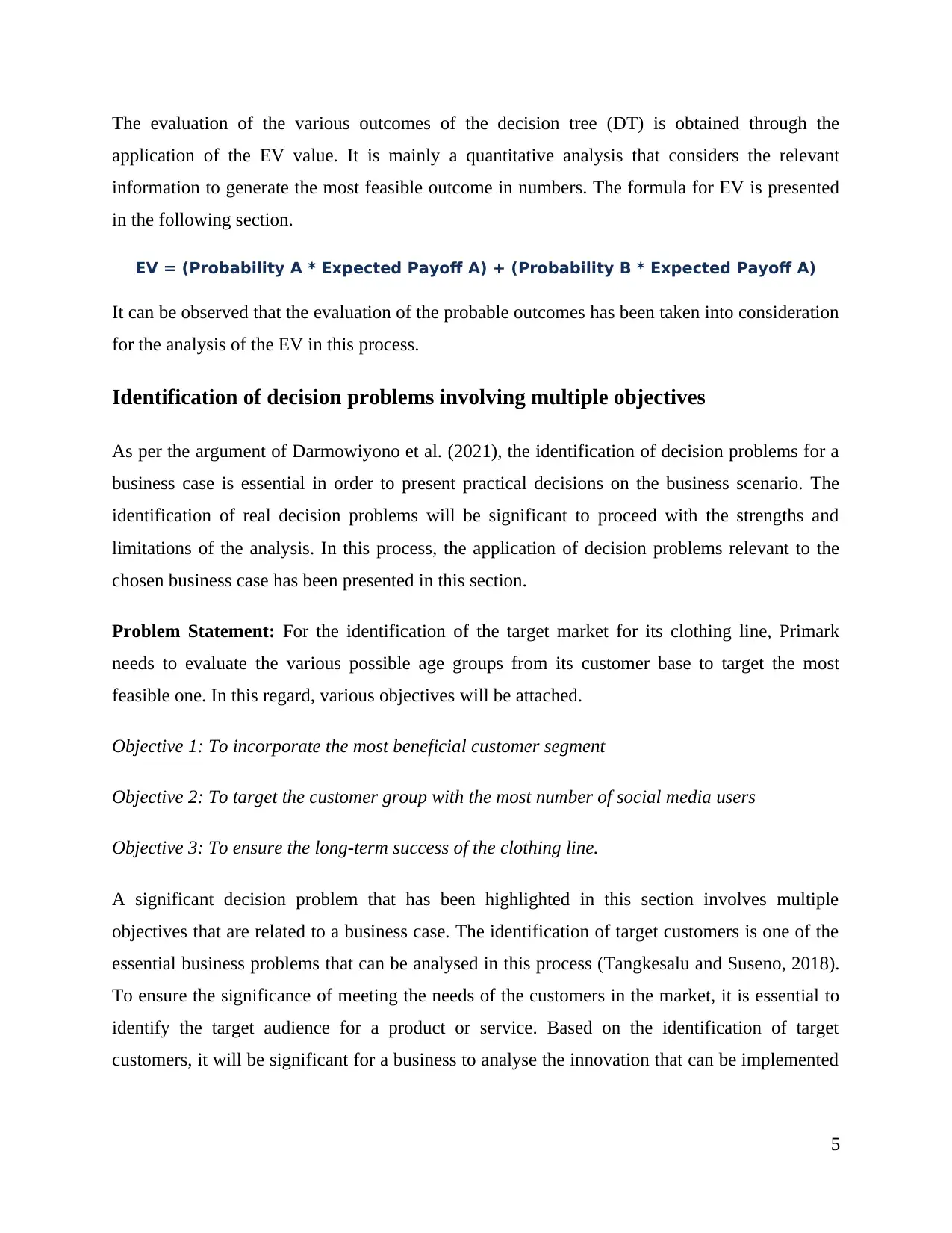
The evaluation of the various outcomes of the decision tree (DT) is obtained through the
application of the EV value. It is mainly a quantitative analysis that considers the relevant
information to generate the most feasible outcome in numbers. The formula for EV is presented
in the following section.
EV = (Probability A * Expected Payoff A) + (Probability B * Expected Payoff A)
It can be observed that the evaluation of the probable outcomes has been taken into consideration
for the analysis of the EV in this process.
Identification of decision problems involving multiple objectives
As per the argument of Darmowiyono et al. (2021), the identification of decision problems for a
business case is essential in order to present practical decisions on the business scenario. The
identification of real decision problems will be significant to proceed with the strengths and
limitations of the analysis. In this process, the application of decision problems relevant to the
chosen business case has been presented in this section.
Problem Statement: For the identification of the target market for its clothing line, Primark
needs to evaluate the various possible age groups from its customer base to target the most
feasible one. In this regard, various objectives will be attached.
Objective 1: To incorporate the most beneficial customer segment
Objective 2: To target the customer group with the most number of social media users
Objective 3: To ensure the long-term success of the clothing line.
A significant decision problem that has been highlighted in this section involves multiple
objectives that are related to a business case. The identification of target customers is one of the
essential business problems that can be analysed in this process (Tangkesalu and Suseno, 2018).
To ensure the significance of meeting the needs of the customers in the market, it is essential to
identify the target audience for a product or service. Based on the identification of target
customers, it will be significant for a business to analyse the innovation that can be implemented
5
application of the EV value. It is mainly a quantitative analysis that considers the relevant
information to generate the most feasible outcome in numbers. The formula for EV is presented
in the following section.
EV = (Probability A * Expected Payoff A) + (Probability B * Expected Payoff A)
It can be observed that the evaluation of the probable outcomes has been taken into consideration
for the analysis of the EV in this process.
Identification of decision problems involving multiple objectives
As per the argument of Darmowiyono et al. (2021), the identification of decision problems for a
business case is essential in order to present practical decisions on the business scenario. The
identification of real decision problems will be significant to proceed with the strengths and
limitations of the analysis. In this process, the application of decision problems relevant to the
chosen business case has been presented in this section.
Problem Statement: For the identification of the target market for its clothing line, Primark
needs to evaluate the various possible age groups from its customer base to target the most
feasible one. In this regard, various objectives will be attached.
Objective 1: To incorporate the most beneficial customer segment
Objective 2: To target the customer group with the most number of social media users
Objective 3: To ensure the long-term success of the clothing line.
A significant decision problem that has been highlighted in this section involves multiple
objectives that are related to a business case. The identification of target customers is one of the
essential business problems that can be analysed in this process (Tangkesalu and Suseno, 2018).
To ensure the significance of meeting the needs of the customers in the market, it is essential to
identify the target audience for a product or service. Based on the identification of target
customers, it will be significant for a business to analyse the innovation that can be implemented
5
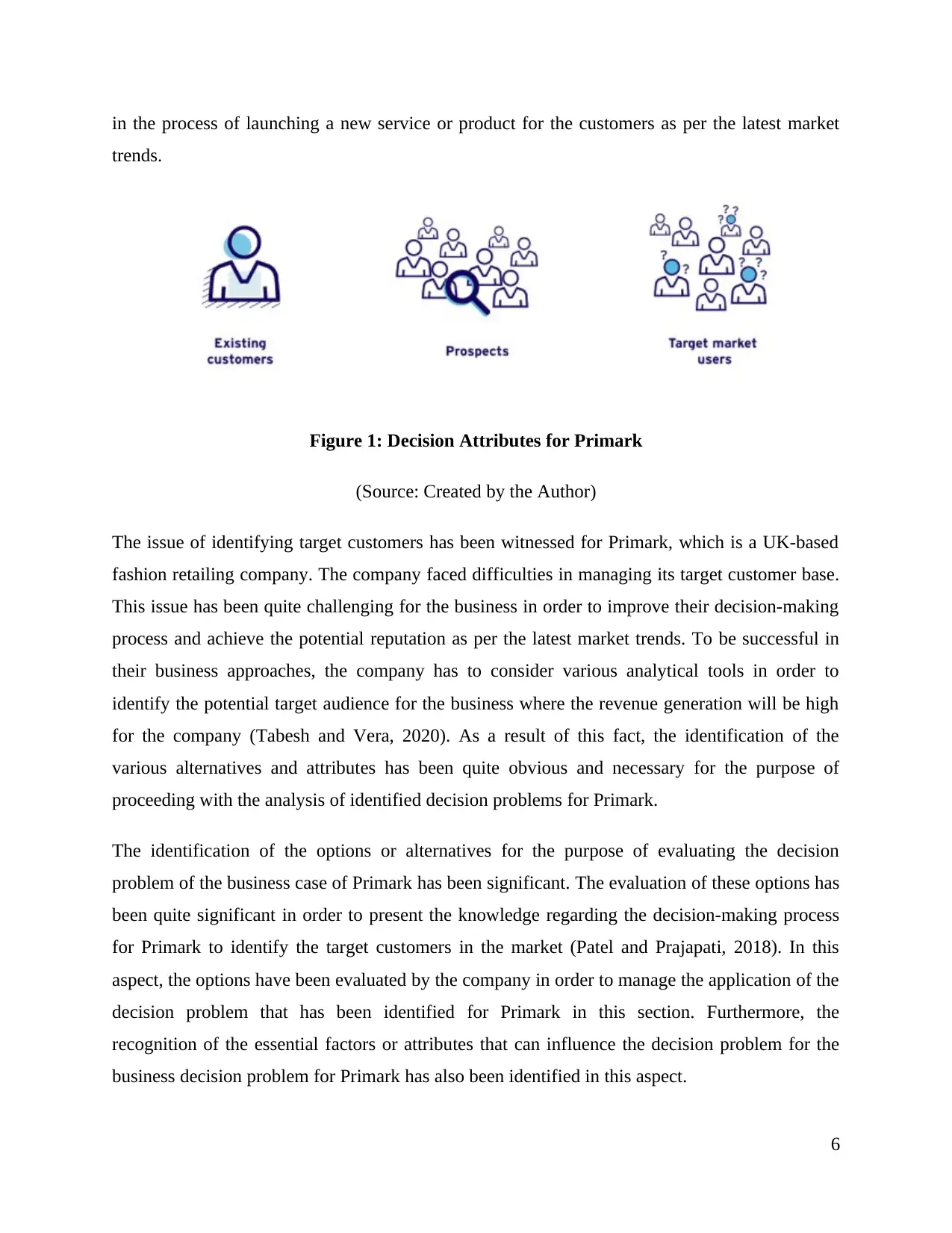
in the process of launching a new service or product for the customers as per the latest market
trends.
Figure 1: Decision Attributes for Primark
(Source: Created by the Author)
The issue of identifying target customers has been witnessed for Primark, which is a UK-based
fashion retailing company. The company faced difficulties in managing its target customer base.
This issue has been quite challenging for the business in order to improve their decision-making
process and achieve the potential reputation as per the latest market trends. To be successful in
their business approaches, the company has to consider various analytical tools in order to
identify the potential target audience for the business where the revenue generation will be high
for the company (Tabesh and Vera, 2020). As a result of this fact, the identification of the
various alternatives and attributes has been quite obvious and necessary for the purpose of
proceeding with the analysis of identified decision problems for Primark.
The identification of the options or alternatives for the purpose of evaluating the decision
problem of the business case of Primark has been significant. The evaluation of these options has
been quite significant in order to present the knowledge regarding the decision-making process
for Primark to identify the target customers in the market (Patel and Prajapati, 2018). In this
aspect, the options have been evaluated by the company in order to manage the application of the
decision problem that has been identified for Primark in this section. Furthermore, the
recognition of the essential factors or attributes that can influence the decision problem for the
business decision problem for Primark has also been identified in this aspect.
6
trends.
Figure 1: Decision Attributes for Primark
(Source: Created by the Author)
The issue of identifying target customers has been witnessed for Primark, which is a UK-based
fashion retailing company. The company faced difficulties in managing its target customer base.
This issue has been quite challenging for the business in order to improve their decision-making
process and achieve the potential reputation as per the latest market trends. To be successful in
their business approaches, the company has to consider various analytical tools in order to
identify the potential target audience for the business where the revenue generation will be high
for the company (Tabesh and Vera, 2020). As a result of this fact, the identification of the
various alternatives and attributes has been quite obvious and necessary for the purpose of
proceeding with the analysis of identified decision problems for Primark.
The identification of the options or alternatives for the purpose of evaluating the decision
problem of the business case of Primark has been significant. The evaluation of these options has
been quite significant in order to present the knowledge regarding the decision-making process
for Primark to identify the target customers in the market (Patel and Prajapati, 2018). In this
aspect, the options have been evaluated by the company in order to manage the application of the
decision problem that has been identified for Primark in this section. Furthermore, the
recognition of the essential factors or attributes that can influence the decision problem for the
business decision problem for Primark has also been identified in this aspect.
6
⊘ This is a preview!⊘
Do you want full access?
Subscribe today to unlock all pages.

Trusted by 1+ million students worldwide
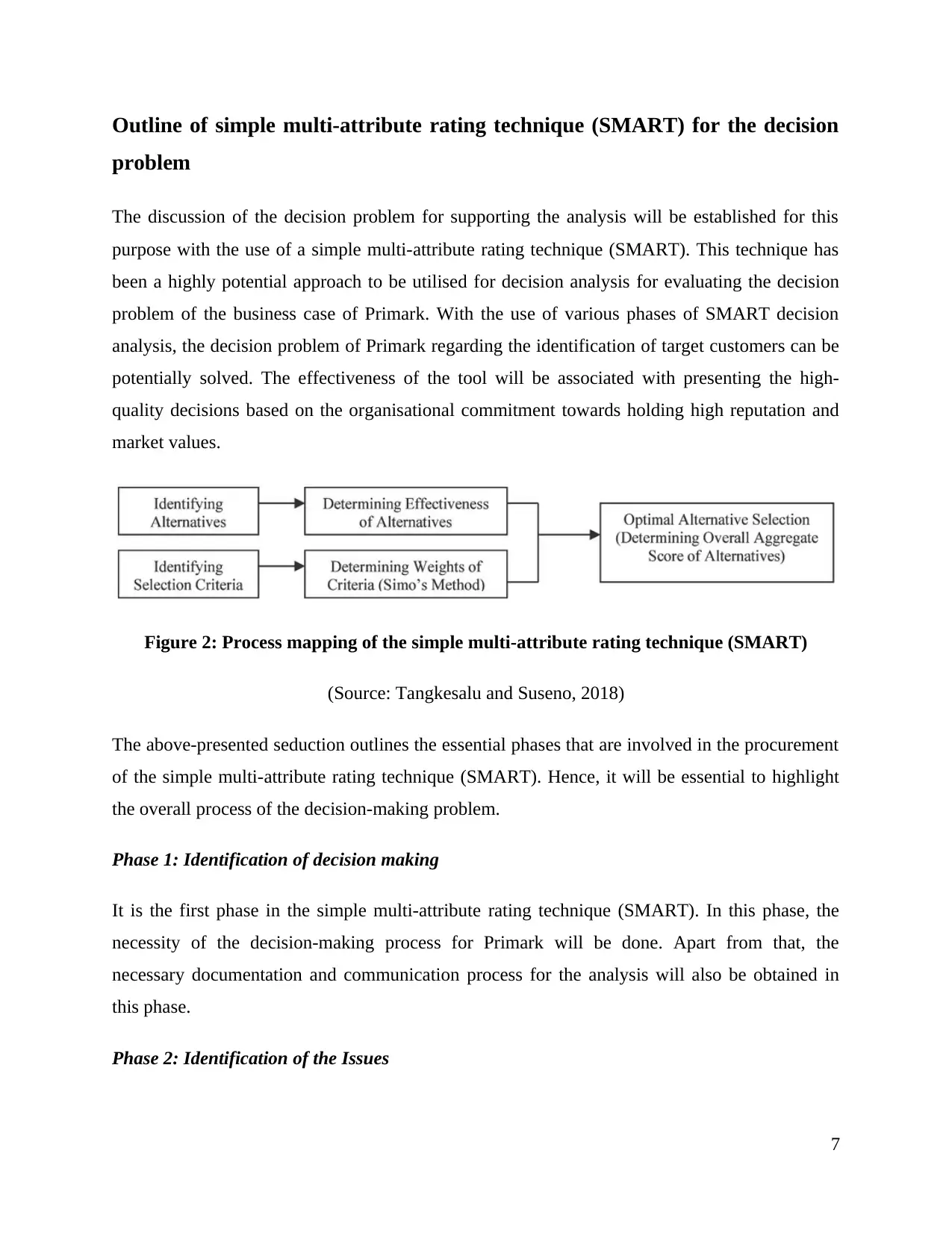
Outline of simple multi-attribute rating technique (SMART) for the decision
problem
The discussion of the decision problem for supporting the analysis will be established for this
purpose with the use of a simple multi-attribute rating technique (SMART). This technique has
been a highly potential approach to be utilised for decision analysis for evaluating the decision
problem of the business case of Primark. With the use of various phases of SMART decision
analysis, the decision problem of Primark regarding the identification of target customers can be
potentially solved. The effectiveness of the tool will be associated with presenting the high-
quality decisions based on the organisational commitment towards holding high reputation and
market values.
Figure 2: Process mapping of the simple multi-attribute rating technique (SMART)
(Source: Tangkesalu and Suseno, 2018)
The above-presented seduction outlines the essential phases that are involved in the procurement
of the simple multi-attribute rating technique (SMART). Hence, it will be essential to highlight
the overall process of the decision-making problem.
Phase 1: Identification of decision making
It is the first phase in the simple multi-attribute rating technique (SMART). In this phase, the
necessity of the decision-making process for Primark will be done. Apart from that, the
necessary documentation and communication process for the analysis will also be obtained in
this phase.
Phase 2: Identification of the Issues
7
problem
The discussion of the decision problem for supporting the analysis will be established for this
purpose with the use of a simple multi-attribute rating technique (SMART). This technique has
been a highly potential approach to be utilised for decision analysis for evaluating the decision
problem of the business case of Primark. With the use of various phases of SMART decision
analysis, the decision problem of Primark regarding the identification of target customers can be
potentially solved. The effectiveness of the tool will be associated with presenting the high-
quality decisions based on the organisational commitment towards holding high reputation and
market values.
Figure 2: Process mapping of the simple multi-attribute rating technique (SMART)
(Source: Tangkesalu and Suseno, 2018)
The above-presented seduction outlines the essential phases that are involved in the procurement
of the simple multi-attribute rating technique (SMART). Hence, it will be essential to highlight
the overall process of the decision-making problem.
Phase 1: Identification of decision making
It is the first phase in the simple multi-attribute rating technique (SMART). In this phase, the
necessity of the decision-making process for Primark will be done. Apart from that, the
necessary documentation and communication process for the analysis will also be obtained in
this phase.
Phase 2: Identification of the Issues
7
Paraphrase This Document
Need a fresh take? Get an instant paraphrase of this document with our AI Paraphraser
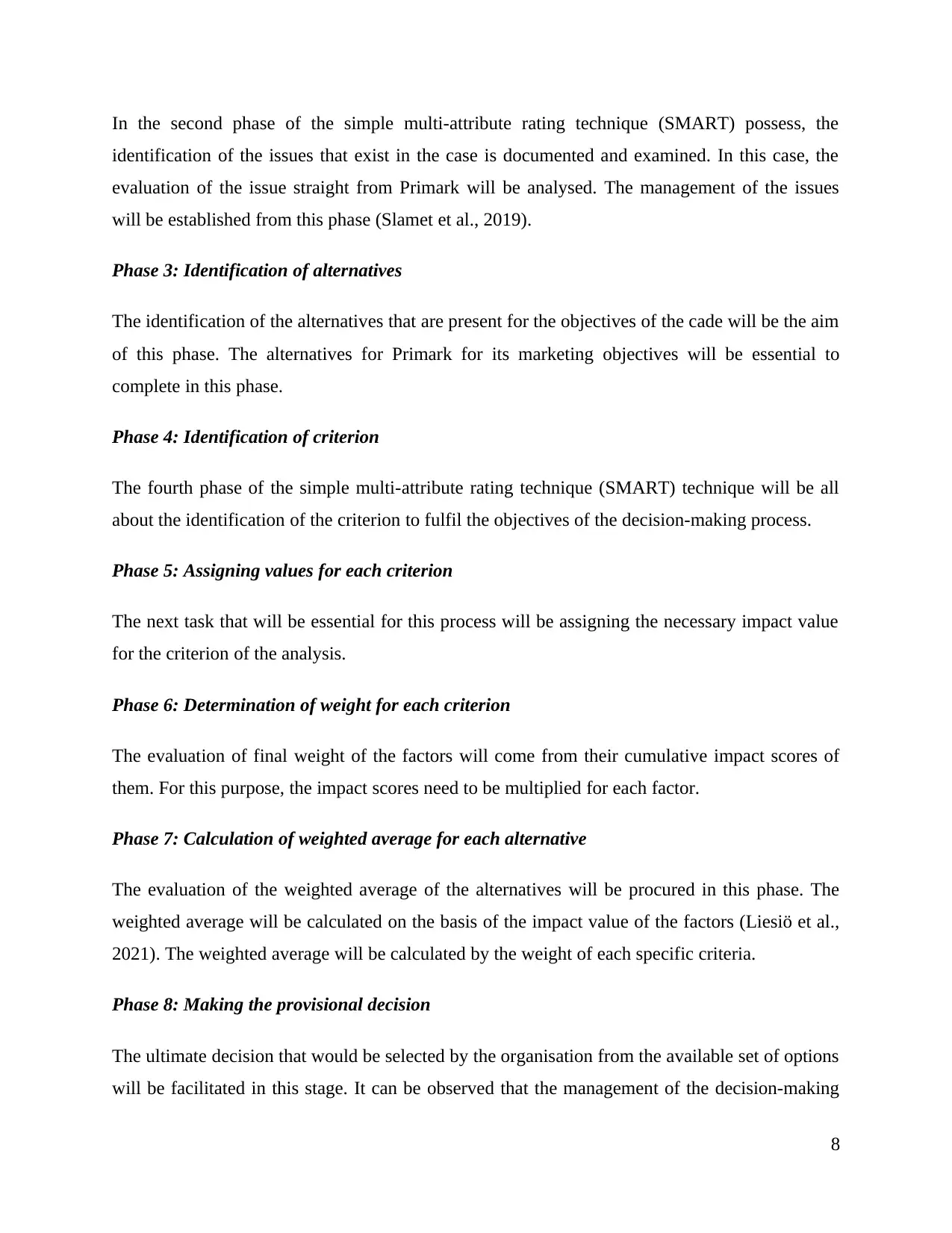
In the second phase of the simple multi-attribute rating technique (SMART) possess, the
identification of the issues that exist in the case is documented and examined. In this case, the
evaluation of the issue straight from Primark will be analysed. The management of the issues
will be established from this phase (Slamet et al., 2019).
Phase 3: Identification of alternatives
The identification of the alternatives that are present for the objectives of the cade will be the aim
of this phase. The alternatives for Primark for its marketing objectives will be essential to
complete in this phase.
Phase 4: Identification of criterion
The fourth phase of the simple multi-attribute rating technique (SMART) technique will be all
about the identification of the criterion to fulfil the objectives of the decision-making process.
Phase 5: Assigning values for each criterion
The next task that will be essential for this process will be assigning the necessary impact value
for the criterion of the analysis.
Phase 6: Determination of weight for each criterion
The evaluation of final weight of the factors will come from their cumulative impact scores of
them. For this purpose, the impact scores need to be multiplied for each factor.
Phase 7: Calculation of weighted average for each alternative
The evaluation of the weighted average of the alternatives will be procured in this phase. The
weighted average will be calculated on the basis of the impact value of the factors (Liesiö et al.,
2021). The weighted average will be calculated by the weight of each specific criteria.
Phase 8: Making the provisional decision
The ultimate decision that would be selected by the organisation from the available set of options
will be facilitated in this stage. It can be observed that the management of the decision-making
8
identification of the issues that exist in the case is documented and examined. In this case, the
evaluation of the issue straight from Primark will be analysed. The management of the issues
will be established from this phase (Slamet et al., 2019).
Phase 3: Identification of alternatives
The identification of the alternatives that are present for the objectives of the cade will be the aim
of this phase. The alternatives for Primark for its marketing objectives will be essential to
complete in this phase.
Phase 4: Identification of criterion
The fourth phase of the simple multi-attribute rating technique (SMART) technique will be all
about the identification of the criterion to fulfil the objectives of the decision-making process.
Phase 5: Assigning values for each criterion
The next task that will be essential for this process will be assigning the necessary impact value
for the criterion of the analysis.
Phase 6: Determination of weight for each criterion
The evaluation of final weight of the factors will come from their cumulative impact scores of
them. For this purpose, the impact scores need to be multiplied for each factor.
Phase 7: Calculation of weighted average for each alternative
The evaluation of the weighted average of the alternatives will be procured in this phase. The
weighted average will be calculated on the basis of the impact value of the factors (Liesiö et al.,
2021). The weighted average will be calculated by the weight of each specific criteria.
Phase 8: Making the provisional decision
The ultimate decision that would be selected by the organisation from the available set of options
will be facilitated in this stage. It can be observed that the management of the decision-making
8
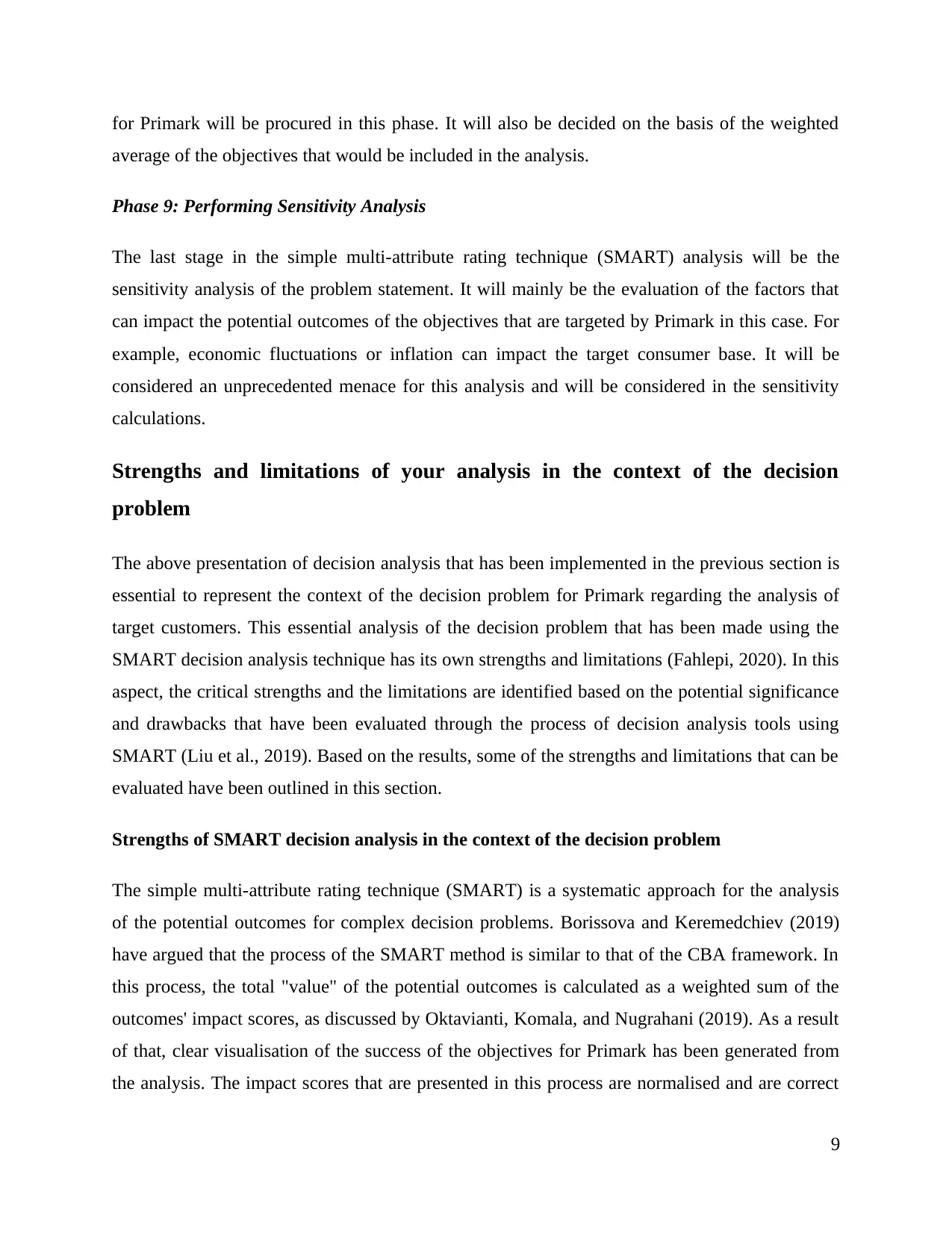
for Primark will be procured in this phase. It will also be decided on the basis of the weighted
average of the objectives that would be included in the analysis.
Phase 9: Performing Sensitivity Analysis
The last stage in the simple multi-attribute rating technique (SMART) analysis will be the
sensitivity analysis of the problem statement. It will mainly be the evaluation of the factors that
can impact the potential outcomes of the objectives that are targeted by Primark in this case. For
example, economic fluctuations or inflation can impact the target consumer base. It will be
considered an unprecedented menace for this analysis and will be considered in the sensitivity
calculations.
Strengths and limitations of your analysis in the context of the decision
problem
The above presentation of decision analysis that has been implemented in the previous section is
essential to represent the context of the decision problem for Primark regarding the analysis of
target customers. This essential analysis of the decision problem that has been made using the
SMART decision analysis technique has its own strengths and limitations (Fahlepi, 2020). In this
aspect, the critical strengths and the limitations are identified based on the potential significance
and drawbacks that have been evaluated through the process of decision analysis tools using
SMART (Liu et al., 2019). Based on the results, some of the strengths and limitations that can be
evaluated have been outlined in this section.
Strengths of SMART decision analysis in the context of the decision problem
The simple multi-attribute rating technique (SMART) is a systematic approach for the analysis
of the potential outcomes for complex decision problems. Borissova and Keremedchiev (2019)
have argued that the process of the SMART method is similar to that of the CBA framework. In
this process, the total "value" of the potential outcomes is calculated as a weighted sum of the
outcomes' impact scores, as discussed by Oktavianti, Komala, and Nugrahani (2019). As a result
of that, clear visualisation of the success of the objectives for Primark has been generated from
the analysis. The impact scores that are presented in this process are normalised and are correct
9
average of the objectives that would be included in the analysis.
Phase 9: Performing Sensitivity Analysis
The last stage in the simple multi-attribute rating technique (SMART) analysis will be the
sensitivity analysis of the problem statement. It will mainly be the evaluation of the factors that
can impact the potential outcomes of the objectives that are targeted by Primark in this case. For
example, economic fluctuations or inflation can impact the target consumer base. It will be
considered an unprecedented menace for this analysis and will be considered in the sensitivity
calculations.
Strengths and limitations of your analysis in the context of the decision
problem
The above presentation of decision analysis that has been implemented in the previous section is
essential to represent the context of the decision problem for Primark regarding the analysis of
target customers. This essential analysis of the decision problem that has been made using the
SMART decision analysis technique has its own strengths and limitations (Fahlepi, 2020). In this
aspect, the critical strengths and the limitations are identified based on the potential significance
and drawbacks that have been evaluated through the process of decision analysis tools using
SMART (Liu et al., 2019). Based on the results, some of the strengths and limitations that can be
evaluated have been outlined in this section.
Strengths of SMART decision analysis in the context of the decision problem
The simple multi-attribute rating technique (SMART) is a systematic approach for the analysis
of the potential outcomes for complex decision problems. Borissova and Keremedchiev (2019)
have argued that the process of the SMART method is similar to that of the CBA framework. In
this process, the total "value" of the potential outcomes is calculated as a weighted sum of the
outcomes' impact scores, as discussed by Oktavianti, Komala, and Nugrahani (2019). As a result
of that, clear visualisation of the success of the objectives for Primark has been generated from
the analysis. The impact scores that are presented in this process are normalised and are correct
9
⊘ This is a preview!⊘
Do you want full access?
Subscribe today to unlock all pages.

Trusted by 1+ million students worldwide
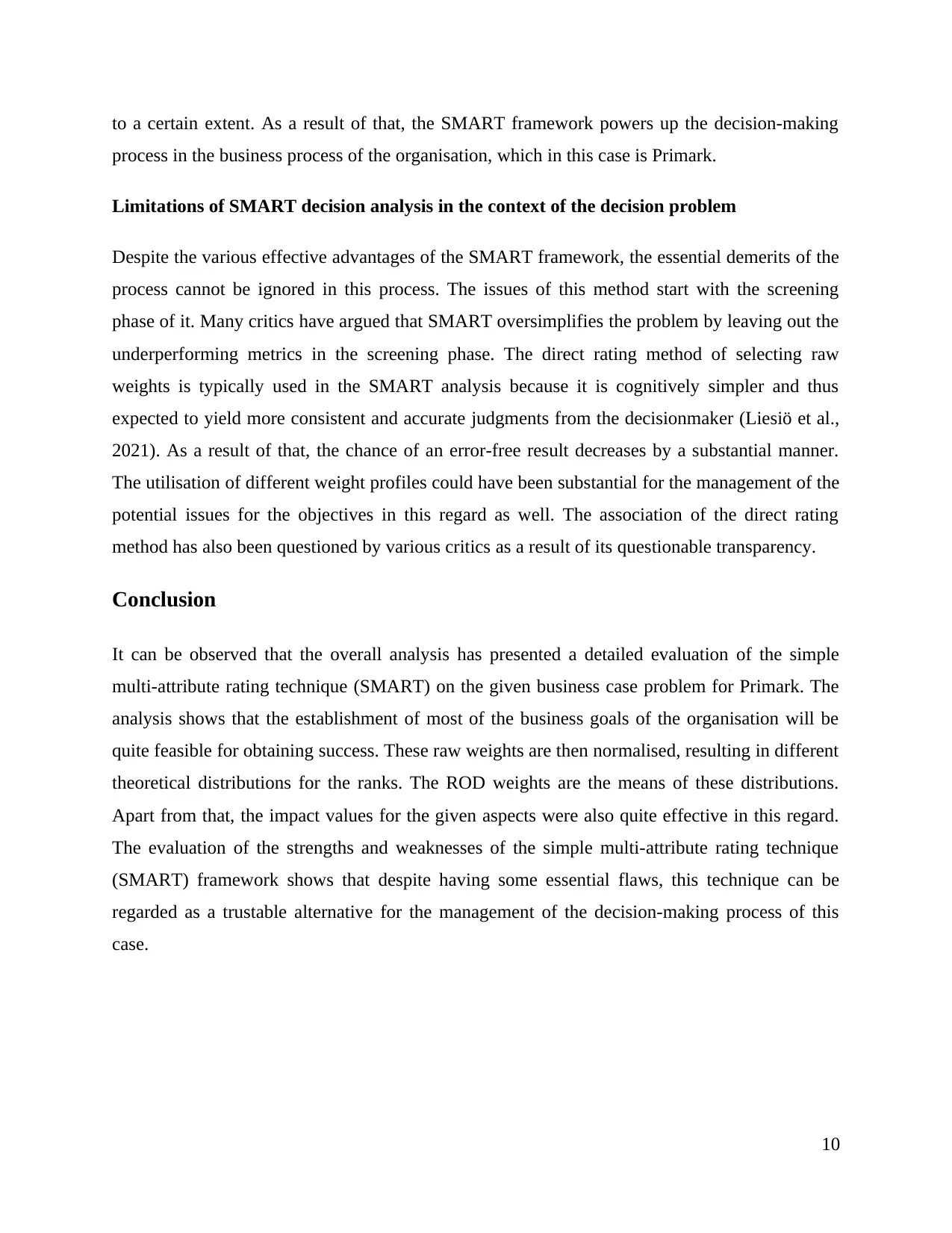
to a certain extent. As a result of that, the SMART framework powers up the decision-making
process in the business process of the organisation, which in this case is Primark.
Limitations of SMART decision analysis in the context of the decision problem
Despite the various effective advantages of the SMART framework, the essential demerits of the
process cannot be ignored in this process. The issues of this method start with the screening
phase of it. Many critics have argued that SMART oversimplifies the problem by leaving out the
underperforming metrics in the screening phase. The direct rating method of selecting raw
weights is typically used in the SMART analysis because it is cognitively simpler and thus
expected to yield more consistent and accurate judgments from the decisionmaker (Liesiö et al.,
2021). As a result of that, the chance of an error-free result decreases by a substantial manner.
The utilisation of different weight profiles could have been substantial for the management of the
potential issues for the objectives in this regard as well. The association of the direct rating
method has also been questioned by various critics as a result of its questionable transparency.
Conclusion
It can be observed that the overall analysis has presented a detailed evaluation of the simple
multi-attribute rating technique (SMART) on the given business case problem for Primark. The
analysis shows that the establishment of most of the business goals of the organisation will be
quite feasible for obtaining success. These raw weights are then normalised, resulting in different
theoretical distributions for the ranks. The ROD weights are the means of these distributions.
Apart from that, the impact values for the given aspects were also quite effective in this regard.
The evaluation of the strengths and weaknesses of the simple multi-attribute rating technique
(SMART) framework shows that despite having some essential flaws, this technique can be
regarded as a trustable alternative for the management of the decision-making process of this
case.
10
process in the business process of the organisation, which in this case is Primark.
Limitations of SMART decision analysis in the context of the decision problem
Despite the various effective advantages of the SMART framework, the essential demerits of the
process cannot be ignored in this process. The issues of this method start with the screening
phase of it. Many critics have argued that SMART oversimplifies the problem by leaving out the
underperforming metrics in the screening phase. The direct rating method of selecting raw
weights is typically used in the SMART analysis because it is cognitively simpler and thus
expected to yield more consistent and accurate judgments from the decisionmaker (Liesiö et al.,
2021). As a result of that, the chance of an error-free result decreases by a substantial manner.
The utilisation of different weight profiles could have been substantial for the management of the
potential issues for the objectives in this regard as well. The association of the direct rating
method has also been questioned by various critics as a result of its questionable transparency.
Conclusion
It can be observed that the overall analysis has presented a detailed evaluation of the simple
multi-attribute rating technique (SMART) on the given business case problem for Primark. The
analysis shows that the establishment of most of the business goals of the organisation will be
quite feasible for obtaining success. These raw weights are then normalised, resulting in different
theoretical distributions for the ranks. The ROD weights are the means of these distributions.
Apart from that, the impact values for the given aspects were also quite effective in this regard.
The evaluation of the strengths and weaknesses of the simple multi-attribute rating technique
(SMART) framework shows that despite having some essential flaws, this technique can be
regarded as a trustable alternative for the management of the decision-making process of this
case.
10
Paraphrase This Document
Need a fresh take? Get an instant paraphrase of this document with our AI Paraphraser
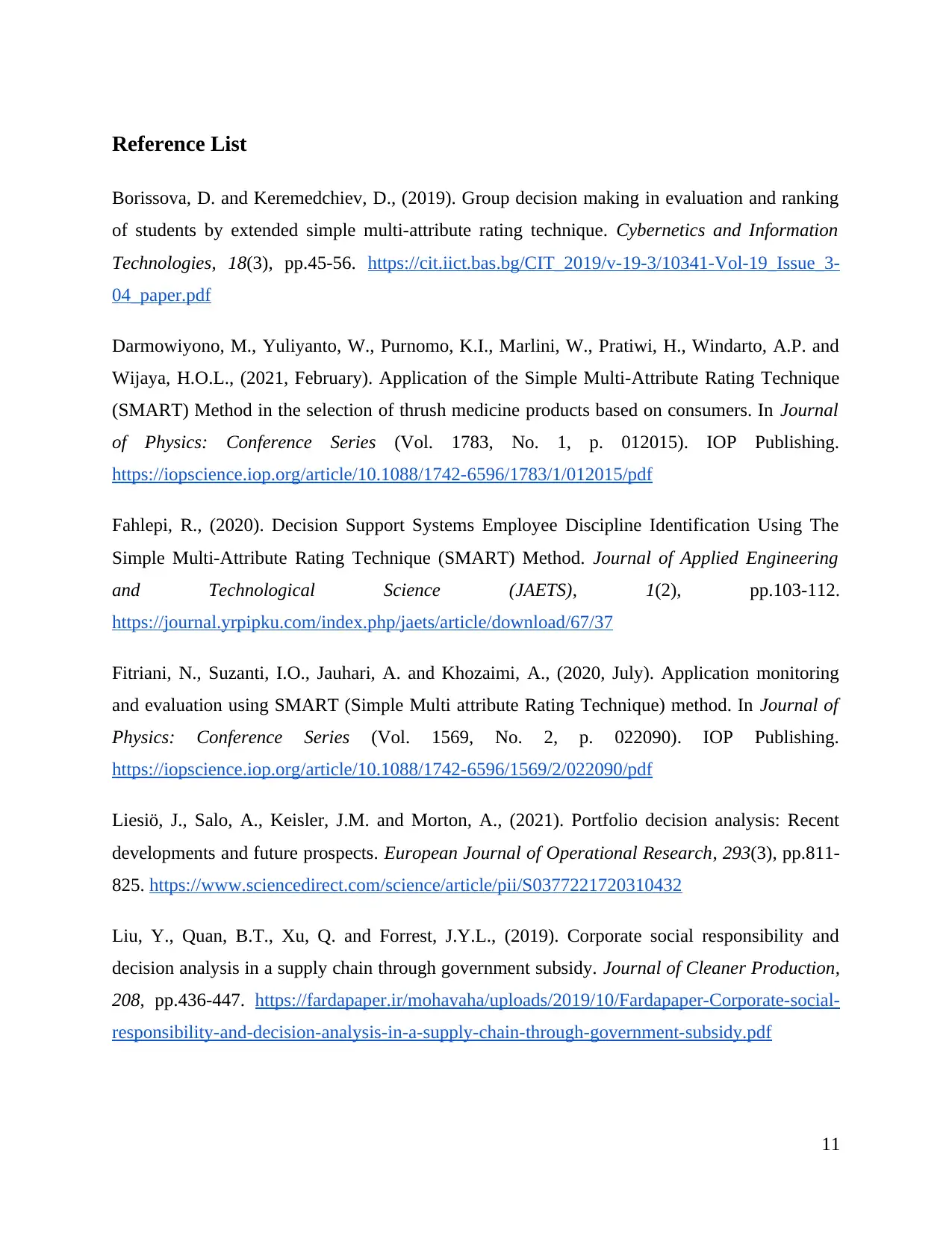
Reference List
Borissova, D. and Keremedchiev, D., (2019). Group decision making in evaluation and ranking
of students by extended simple multi-attribute rating technique. Cybernetics and Information
Technologies, 18(3), pp.45-56. https://cit.iict.bas.bg/CIT_2019/v-19-3/10341-Vol-19_Issue_3-
04_paper.pdf
Darmowiyono, M., Yuliyanto, W., Purnomo, K.I., Marlini, W., Pratiwi, H., Windarto, A.P. and
Wijaya, H.O.L., (2021, February). Application of the Simple Multi-Attribute Rating Technique
(SMART) Method in the selection of thrush medicine products based on consumers. In Journal
of Physics: Conference Series (Vol. 1783, No. 1, p. 012015). IOP Publishing.
https://iopscience.iop.org/article/10.1088/1742-6596/1783/1/012015/pdf
Fahlepi, R., (2020). Decision Support Systems Employee Discipline Identification Using The
Simple Multi-Attribute Rating Technique (SMART) Method. Journal of Applied Engineering
and Technological Science (JAETS), 1(2), pp.103-112.
https://journal.yrpipku.com/index.php/jaets/article/download/67/37
Fitriani, N., Suzanti, I.O., Jauhari, A. and Khozaimi, A., (2020, July). Application monitoring
and evaluation using SMART (Simple Multi attribute Rating Technique) method. In Journal of
Physics: Conference Series (Vol. 1569, No. 2, p. 022090). IOP Publishing.
https://iopscience.iop.org/article/10.1088/1742-6596/1569/2/022090/pdf
Liesiö, J., Salo, A., Keisler, J.M. and Morton, A., (2021). Portfolio decision analysis: Recent
developments and future prospects. European Journal of Operational Research, 293(3), pp.811-
825. https://www.sciencedirect.com/science/article/pii/S0377221720310432
Liu, Y., Quan, B.T., Xu, Q. and Forrest, J.Y.L., (2019). Corporate social responsibility and
decision analysis in a supply chain through government subsidy. Journal of Cleaner Production,
208, pp.436-447. https://fardapaper.ir/mohavaha/uploads/2019/10/Fardapaper-Corporate-social-
responsibility-and-decision-analysis-in-a-supply-chain-through-government-subsidy.pdf
11
Borissova, D. and Keremedchiev, D., (2019). Group decision making in evaluation and ranking
of students by extended simple multi-attribute rating technique. Cybernetics and Information
Technologies, 18(3), pp.45-56. https://cit.iict.bas.bg/CIT_2019/v-19-3/10341-Vol-19_Issue_3-
04_paper.pdf
Darmowiyono, M., Yuliyanto, W., Purnomo, K.I., Marlini, W., Pratiwi, H., Windarto, A.P. and
Wijaya, H.O.L., (2021, February). Application of the Simple Multi-Attribute Rating Technique
(SMART) Method in the selection of thrush medicine products based on consumers. In Journal
of Physics: Conference Series (Vol. 1783, No. 1, p. 012015). IOP Publishing.
https://iopscience.iop.org/article/10.1088/1742-6596/1783/1/012015/pdf
Fahlepi, R., (2020). Decision Support Systems Employee Discipline Identification Using The
Simple Multi-Attribute Rating Technique (SMART) Method. Journal of Applied Engineering
and Technological Science (JAETS), 1(2), pp.103-112.
https://journal.yrpipku.com/index.php/jaets/article/download/67/37
Fitriani, N., Suzanti, I.O., Jauhari, A. and Khozaimi, A., (2020, July). Application monitoring
and evaluation using SMART (Simple Multi attribute Rating Technique) method. In Journal of
Physics: Conference Series (Vol. 1569, No. 2, p. 022090). IOP Publishing.
https://iopscience.iop.org/article/10.1088/1742-6596/1569/2/022090/pdf
Liesiö, J., Salo, A., Keisler, J.M. and Morton, A., (2021). Portfolio decision analysis: Recent
developments and future prospects. European Journal of Operational Research, 293(3), pp.811-
825. https://www.sciencedirect.com/science/article/pii/S0377221720310432
Liu, Y., Quan, B.T., Xu, Q. and Forrest, J.Y.L., (2019). Corporate social responsibility and
decision analysis in a supply chain through government subsidy. Journal of Cleaner Production,
208, pp.436-447. https://fardapaper.ir/mohavaha/uploads/2019/10/Fardapaper-Corporate-social-
responsibility-and-decision-analysis-in-a-supply-chain-through-government-subsidy.pdf
11
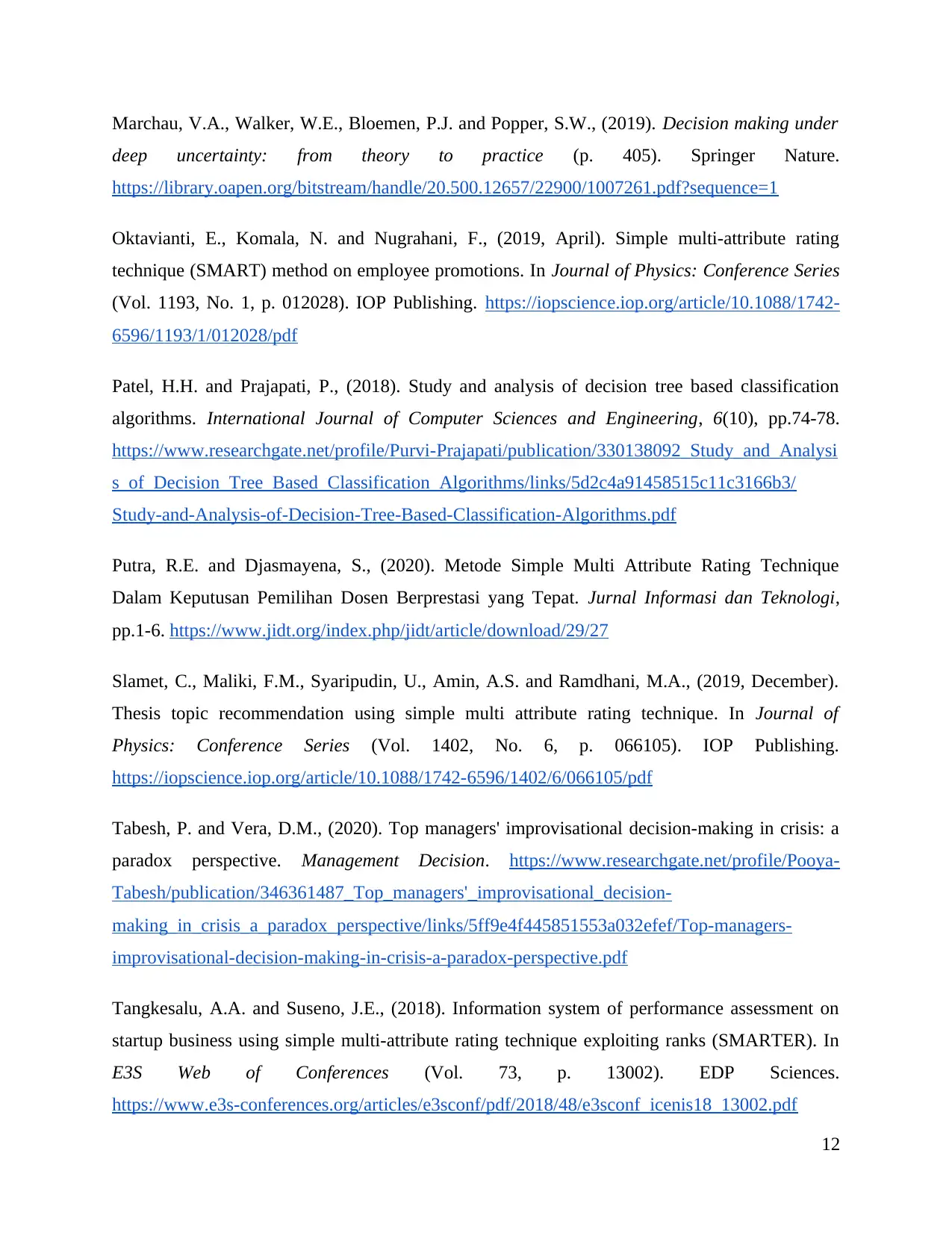
Marchau, V.A., Walker, W.E., Bloemen, P.J. and Popper, S.W., (2019). Decision making under
deep uncertainty: from theory to practice (p. 405). Springer Nature.
https://library.oapen.org/bitstream/handle/20.500.12657/22900/1007261.pdf?sequence=1
Oktavianti, E., Komala, N. and Nugrahani, F., (2019, April). Simple multi-attribute rating
technique (SMART) method on employee promotions. In Journal of Physics: Conference Series
(Vol. 1193, No. 1, p. 012028). IOP Publishing. https://iopscience.iop.org/article/10.1088/1742-
6596/1193/1/012028/pdf
Patel, H.H. and Prajapati, P., (2018). Study and analysis of decision tree based classification
algorithms. International Journal of Computer Sciences and Engineering, 6(10), pp.74-78.
https://www.researchgate.net/profile/Purvi-Prajapati/publication/330138092_Study_and_Analysi
s_of_Decision_Tree_Based_Classification_Algorithms/links/5d2c4a91458515c11c3166b3/
Study-and-Analysis-of-Decision-Tree-Based-Classification-Algorithms.pdf
Putra, R.E. and Djasmayena, S., (2020). Metode Simple Multi Attribute Rating Technique
Dalam Keputusan Pemilihan Dosen Berprestasi yang Tepat. Jurnal Informasi dan Teknologi,
pp.1-6. https://www.jidt.org/index.php/jidt/article/download/29/27
Slamet, C., Maliki, F.M., Syaripudin, U., Amin, A.S. and Ramdhani, M.A., (2019, December).
Thesis topic recommendation using simple multi attribute rating technique. In Journal of
Physics: Conference Series (Vol. 1402, No. 6, p. 066105). IOP Publishing.
https://iopscience.iop.org/article/10.1088/1742-6596/1402/6/066105/pdf
Tabesh, P. and Vera, D.M., (2020). Top managers' improvisational decision-making in crisis: a
paradox perspective. Management Decision. https://www.researchgate.net/profile/Pooya-
Tabesh/publication/346361487_Top_managers'_improvisational_decision-
making_in_crisis_a_paradox_perspective/links/5ff9e4f445851553a032efef/Top-managers-
improvisational-decision-making-in-crisis-a-paradox-perspective.pdf
Tangkesalu, A.A. and Suseno, J.E., (2018). Information system of performance assessment on
startup business using simple multi-attribute rating technique exploiting ranks (SMARTER). In
E3S Web of Conferences (Vol. 73, p. 13002). EDP Sciences.
https://www.e3s-conferences.org/articles/e3sconf/pdf/2018/48/e3sconf_icenis18_13002.pdf
12
deep uncertainty: from theory to practice (p. 405). Springer Nature.
https://library.oapen.org/bitstream/handle/20.500.12657/22900/1007261.pdf?sequence=1
Oktavianti, E., Komala, N. and Nugrahani, F., (2019, April). Simple multi-attribute rating
technique (SMART) method on employee promotions. In Journal of Physics: Conference Series
(Vol. 1193, No. 1, p. 012028). IOP Publishing. https://iopscience.iop.org/article/10.1088/1742-
6596/1193/1/012028/pdf
Patel, H.H. and Prajapati, P., (2018). Study and analysis of decision tree based classification
algorithms. International Journal of Computer Sciences and Engineering, 6(10), pp.74-78.
https://www.researchgate.net/profile/Purvi-Prajapati/publication/330138092_Study_and_Analysi
s_of_Decision_Tree_Based_Classification_Algorithms/links/5d2c4a91458515c11c3166b3/
Study-and-Analysis-of-Decision-Tree-Based-Classification-Algorithms.pdf
Putra, R.E. and Djasmayena, S., (2020). Metode Simple Multi Attribute Rating Technique
Dalam Keputusan Pemilihan Dosen Berprestasi yang Tepat. Jurnal Informasi dan Teknologi,
pp.1-6. https://www.jidt.org/index.php/jidt/article/download/29/27
Slamet, C., Maliki, F.M., Syaripudin, U., Amin, A.S. and Ramdhani, M.A., (2019, December).
Thesis topic recommendation using simple multi attribute rating technique. In Journal of
Physics: Conference Series (Vol. 1402, No. 6, p. 066105). IOP Publishing.
https://iopscience.iop.org/article/10.1088/1742-6596/1402/6/066105/pdf
Tabesh, P. and Vera, D.M., (2020). Top managers' improvisational decision-making in crisis: a
paradox perspective. Management Decision. https://www.researchgate.net/profile/Pooya-
Tabesh/publication/346361487_Top_managers'_improvisational_decision-
making_in_crisis_a_paradox_perspective/links/5ff9e4f445851553a032efef/Top-managers-
improvisational-decision-making-in-crisis-a-paradox-perspective.pdf
Tangkesalu, A.A. and Suseno, J.E., (2018). Information system of performance assessment on
startup business using simple multi-attribute rating technique exploiting ranks (SMARTER). In
E3S Web of Conferences (Vol. 73, p. 13002). EDP Sciences.
https://www.e3s-conferences.org/articles/e3sconf/pdf/2018/48/e3sconf_icenis18_13002.pdf
12
⊘ This is a preview!⊘
Do you want full access?
Subscribe today to unlock all pages.

Trusted by 1+ million students worldwide
1 out of 13
Related Documents
Your All-in-One AI-Powered Toolkit for Academic Success.
+13062052269
info@desklib.com
Available 24*7 on WhatsApp / Email
![[object Object]](/_next/static/media/star-bottom.7253800d.svg)
Unlock your academic potential
Copyright © 2020–2025 A2Z Services. All Rights Reserved. Developed and managed by ZUCOL.





